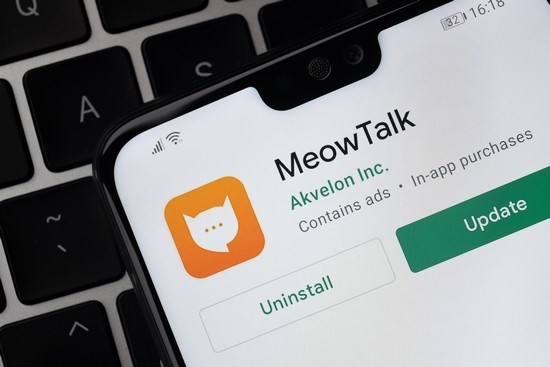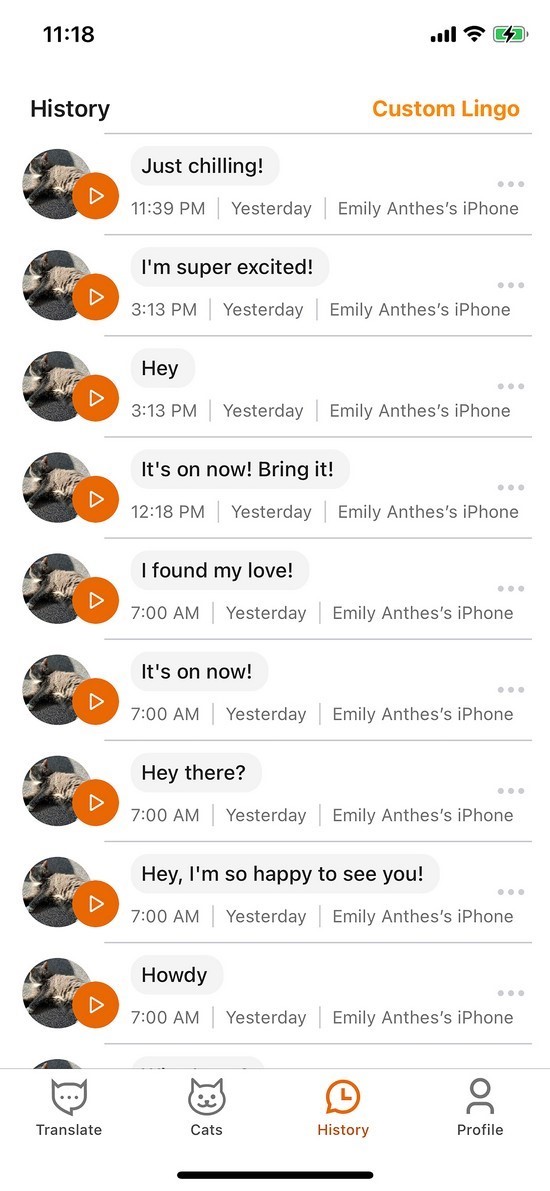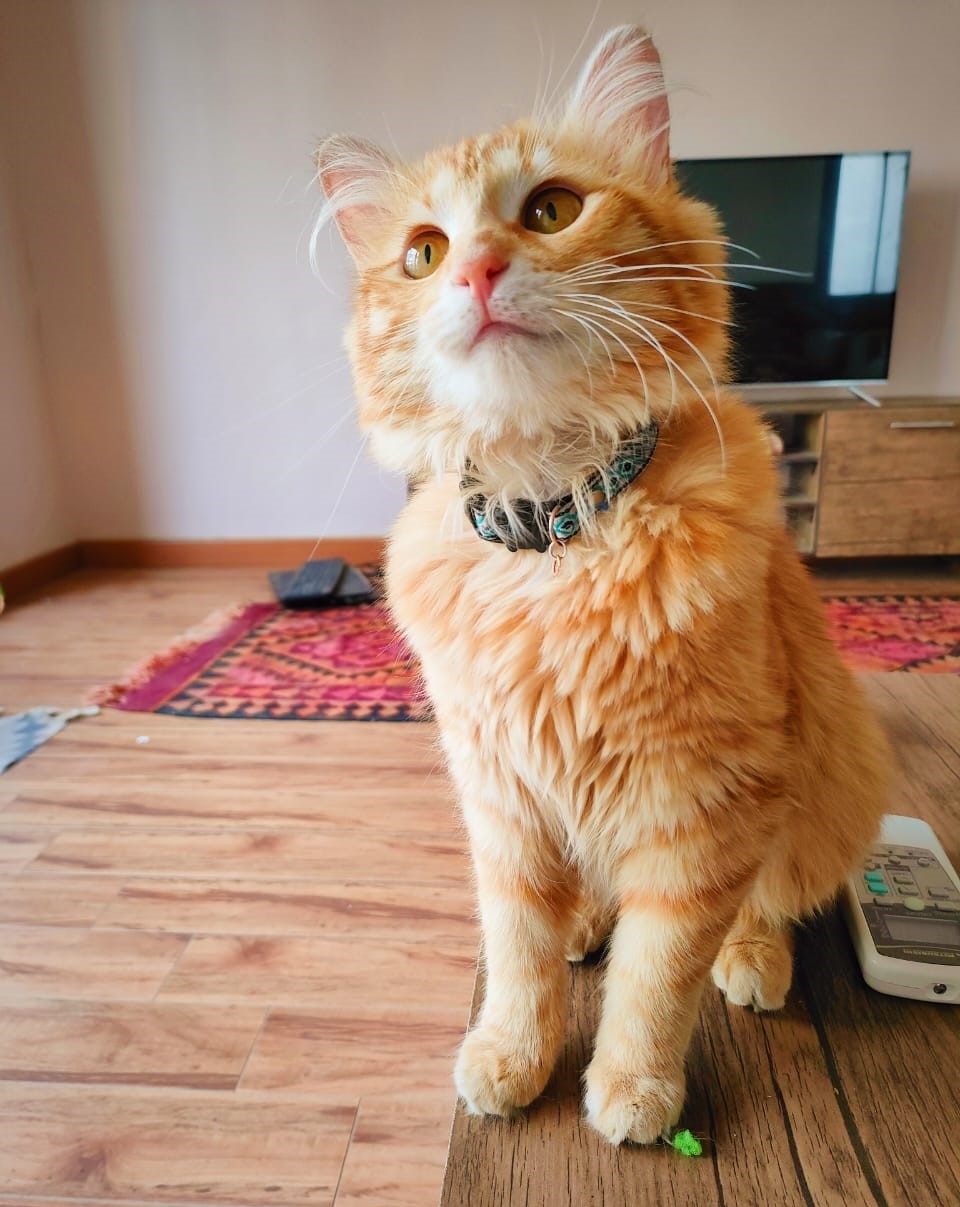My cat
is a bona fide chatterbox. Momo will meow when she is hungry and when she is
full, when she wants to be picked up and when she wants to be put down, when I
leave the room or when I enter it, or sometimes for what appears to be no real
reason at all.
اضافة اعلان
But because she
is a cat, she is also uncooperative. So the moment I downloaded
MeowTalk Cat Translator, a mobile app that promised to convert Momo’s meows into plain
English, she clammed right up. For two days I tried, and failed, to solicit a
sound.
 New apps aim to give us an instant translation of what our pets’ sounds mean. (Photos: NYTimes)
New apps aim to give us an instant translation of what our pets’ sounds mean. (Photos: NYTimes)
On day three,
out of desperation, I decided to pick her up while she was wolfing down her
dinner, an interruption guaranteed to elicit a howl of protest. Right on cue,
Momo wailed. The app processed the sound, then played an advertisement for Sara
Lee, then rendered a translation: “I’m happy!”
I was dubious.
But MeowTalk provided a more plausible translation about a week later, when I
returned from a four-day trip. Upon seeing me, Momo meowed and then purred.
“Nice to see you,” the app translated. Then: “Let me rest.” (The ads
disappeared after I upgraded to a premium account.)
The urge to
converse with
animals is age-old, long predating the time when smartphones
became our best friends. Scientists have taught sign language to great apes,
chatted with grey parrots, and even tried to teach English to bottlenose
dolphins. Pets — with whom we share our homes but not a common language — are
particularly tempting targets. My TikTok feed brims with videos of Bunny, a
sheepadoodle who has learned to press sound buttons that play prerecorded phrases
such as “outside,” “scritches”, and “love you”.

MeowTalk is the
product of a growing interest in enlisting additional intelligences —
machine-learning algorithms — to decode animal communication. The idea is not
as far-fetched as it may seem. For example, machine-learning systems, which are
able to extract patterns from large data sets, can distinguish between the
squeaks that rodents make when they are happy and those that they emit when
they are in distress.
Applying the
same advances to our creature companions has obvious appeal.
“We’re trying to
understand what cats are saying and give them a voice,” said Javier Sanchez, a
founder of MeowTalk. “We want to use this to help people build better and
stronger relationships with their cats.”

To me, an animal
lover in a three-species household — Momo the cranky cat begrudgingly shares
space with Watson the overeager dog — the idea of a pet translation app was
tantalizing. But even MeowTalk’s creators acknowledge that there are still a
few kinks to work out.
Making meowsic
A meow contains multitudes. In the best of feline times — say, when a
cat is being fed — meows tend to be short and high-pitched and have rising
intonations, according to one recent study, which has not yet been published in
a
scientific journal. But in the worst of times (trapped in a cat carrier),
cats generally make their distress known with long, low-pitched meows that have
falling intonations.
“They tend to
use different types of melody in their meows when they try to signal different
things,” said Susanne Schötz, a phonetician at
Lund University in Sweden who
led the study as part of a research project called Meowsic.
MeowTalk uses the sounds it collects to refine its algorithms and improve its performance, the founders said, and pet owners can provide in-the-moment feedback if the app gets it wrong.
And in a 2019
study, Stavros Ntalampiras, a computer scientist at the University of Milan,
demonstrated that algorithms could automatically distinguish between the meows
that cats made in three situations: when being brushed, when waiting for food,
or when left alone in a strange environment.

MeowTalk, whose
founders enlisted Ntalampiras after the study appeared, expands on this
research, using algorithms to identify cat vocalizations made in a variety of
contexts.
The app detects
and analyzes cat utterances in real-time, assigning each one a broadly defined
“intent,” such as happy, resting, hunting, or “mating call”. It then displays a
conversational, plain English “translation” of whatever intent it detects, such
as Momo’s beleaguered “Let me rest”. (Oddly, none of these translations appear
to include “I will chew off your leg if you do not feed me this instant.”)
MeowTalk uses
the sounds it collects to refine its algorithms and improve its performance,
the founders said, and pet owners can provide in-the-moment feedback if the app
gets it wrong.
In 2021,
MeowTalk researchers reported that the software could distinguish among nine
intents with 90 percent accuracy overall. But the app was better at identifying
some than others, not infrequently confusing “happy” and “pain,” according to
the results.
And assessing
the accuracy of a cat translation app is tricky, said Sergei Dreizin, a
MeowTalk founder. “It’s assuming that you actually know what your cat wants,”
he said.

I found that the
app was, as advertised, especially good at detecting purring. (Then again, so
am I.) But it is much harder to determine what the calls in each category mean
— if they carry a consistent meaning at all — without actually having a way of,
you know, communicating with cats. (Cat-ch-22?)
After all, the
precise purpose of purring, which cats do in a wide variety of situations,
remains elusive. MeowTalk, however, interprets purrs as “resting”.
“But to be
candid,” Sanchez said, “it can mean. …” He rephrased: “We don’t know what it
means.”
Deciphering dogs
Dogs could soon have their own day. Zoolingua, a startup based in
Arizona, is hoping to create an artificial intelligence-powered dog translator
that will analyze canine vocalizations and body language.
Dog owners have
been overwhelmingly enthusiastic about the concept, said Con Slobodchikoff,
founder and CEO of Zoolingua, who spent much of his academic career studying
prairie dog communication. “Good communication between you and your dog means
having a great relationship with your dog,” he said. “And a lot of people want
a great relationship with their dog.”
(But, he added,
not everyone: “One small minority says, ‘I don’t think that I really want to
know what my dog is trying to communicate to me because maybe my dog doesn’t
like me.’”)
Still, even sop
histicated algorithms may miss critical real-world context and cues, said
Alexandra Horowitz, an expert on dog cognition at
Barnard College. For
instance, much of canine behavior is driven by scent. “How is that going to be
translated, when we don’t know the extent of it ourselves?” Horowitz said in an
email.
The desire to
understand what animals are “saying,” however, does not seem likely to abate.
The world can be a lonely place, especially so in the past few years. Finding
new ways to connect with other creatures, other species, can be a much needed
balm.
Personally, I
would pay at least two figures for an app that could help me know whether my
dog truly needs to go outside or just wants to see if the neighbor has put
bread out for the birds. (Maybe what I really need is a canine lie-detection
app.) For now, I will simply have to use my own judgment and powers of
observation.
After all, our pets are
already communicating with us all the time, Horowitz said. “It’s far more
interesting to me to learn my own dog’s communications,” she said, “especially
the idiosyncrasies that are formed between particular people and particular
animals, than pretend that an app can — presto! — translate it all.”
Read more Technology
Jordan News



